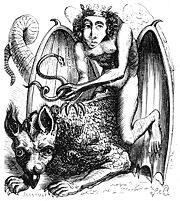
Astaroth
Encyclopedia

Demonology
Demonology is the systematic study of demons or beliefs about demons. It is the branch of theology relating to superhuman beings who are not gods. It deals both with benevolent beings that have no circle of worshippers or so limited a circle as to be below the rank of gods, and with malevolent...
, is a Crowned Prince of Hell
Hell
In many religious traditions, a hell is a place of suffering and punishment in the afterlife. Religions with a linear divine history often depict hells as endless. Religions with a cyclic history often depict a hell as an intermediary period between incarnations...
. He is a male figure named after the Canaan
Canaan
Canaan is a historical region roughly corresponding to modern-day Israel, Palestine, Lebanon, and the western parts of Jordan...
ite goddess Ashtoreth.
Background
The name Astaroth was ultimately derived from that of 2nd millennium BC2nd millennium BC
The 2nd millennium BC marks the transition from the Middle to the Late Bronze Age.Its first half is dominated by the Middle Kingdom of Egypt and Babylonia. The alphabet develops. Indo-Iranian migration onto the Iranian plateau and onto the Indian subcontinent propagates the use of the chariot...
Phoenicia
Phoenicia
Phoenicia , was an ancient civilization in Canaan which covered most of the western, coastal part of the Fertile Crescent. Several major Phoenician cities were built on the coastline of the Mediterranean. It was an enterprising maritime trading culture that spread across the Mediterranean from 1550...
n goddess Astarte
Astarte
Astarte is the Greek name of a goddess known throughout the Eastern Mediterranean from the Bronze Age to Classical times...
, an equivalent of the Babylonian Ishtar
Ishtar
Ishtar is the Assyrian and Babylonian goddess of fertility, love, war, and sex. She is the counterpart to the Sumerian Inanna and to the cognate north-west Semitic goddess Astarte.-Characteristics:...
, and the earlier Sumerian Inanna
Inanna
Inanna, also spelled Inana is the Sumerian goddess of sexual love, fertility, and warfare....
. She is mentioned in the Hebrew Bible
Hebrew Bible
The Hebrew Bible is a term used by biblical scholars outside of Judaism to refer to the Tanakh , a canonical collection of Jewish texts, and the common textual antecedent of the several canonical editions of the Christian Old Testament...
in the forms Ashtoreth (singular) and Ashtaroth (plural, in reference to multiple statues of her). This latter form was directly transliterated in the early Greek and Latin versions of the Bible, where it was less apparent that it had been a plural feminine in Hebrew.
The pseudepigraphal work Testament of Solomon
Testament of Solomon
The Testament of Solomon is an Old Testament pseudepigraphical work, the authorship of which is ascribed to King Solomon. It describes how Solomon was enabled to build the Temple by commanding demons by means of a magical ring entrusted to him by the Archangel Michael.- History :Despite the text's...
, attributed to King Solomon of Israel, but thought to date to the early centuries AD, mentions "Asteraoth" (in Greek) as an angel, who is opposed to the demon of power. (cf. 1 Kings 11:4-5)
The name "Astaroth" as a male demon is first known from The Book of Abramelin, written in Hebrew ca. 1458, and recurred in most occult
Occult
The word occult comes from the Latin word occultus , referring to "knowledge of the hidden". In the medical sense it is used to refer to a structure or process that is hidden, e.g...
grimoires of the following centuries. Astaroth also features as an arch-demon associated with the qliphoth
Qliphoth
Qliphoth/Qelippot, alternatively Klippot/Kellipot etc. refers to the representation of evil or impure spiritual forces in Jewish mysticism.In the Kabbalistic spiritual cosmology, the Kelipot are metaphorical "shells" surrounding holiness...
(adverse forces) according to later Kabbalistic texts.

The Lesser Key of Solomon
The Lesser Key of Solomon or Clavicula Salomonis , is an anonymous 17th-century grimoire, and one of the most popular books of demonology...
as a very powerful demon. In art, in the Dictionnaire Infernal
Dictionnaire Infernal
The Dictionnaire Infernal is a book on demonology, organised in hellish hierarchies. It was written by Jacques Auguste Simon Collin de Plancy and first published in 1818. There were several editions of the book, but perhaps the most famous is the edition of 1863, in which sixty-nine illustrations...
, Astaroth is depicted as a nude man with feathered wings, wearing a crown, holding a serpent
Serpent (symbolism)
Serpent in Latin means: Rory Collins :&, in turn, from the Biblical Hebrew word of: "saraf" with root letters of: which refers to something burning-as, the pain of poisonous snake's bite was likened to internal burning.This word is commonly used in a specifically mythic or religious context,...
in one hand, and riding a beast with dragon
Dragon
A dragon is a legendary creature, typically with serpentine or reptilian traits, that feature in the myths of many cultures. There are two distinct cultural traditions of dragons: the European dragon, derived from European folk traditions and ultimately related to Greek and Middle Eastern...
-like wings and a serpent-like tail. According to Sebastien Michaelis
Sebastien Michaelis
Sebastien Michaelis was a French inquisitor and prior of the Dominican order who lived during the late 16th and early 17th centuries. His Histoire admirable de la possession d'une penitente , includes a classification of demons which has passed into general use in esoteric literature.-Early...
he is a demon
Demonology
Demonology is the systematic study of demons or beliefs about demons. It is the branch of theology relating to superhuman beings who are not gods. It deals both with benevolent beings that have no circle of worshippers or so limited a circle as to be below the rank of gods, and with malevolent...
of the First Hierarchy, who seduces by means of laziness, vanity, and rationalized philosophies. His adversary is St. Bartholomew
Bartholomew
Bartholomew was one of the Twelve Apostles of Jesus, and is usually identified as Nathaniel . He was introduced to Christ through St. Philip, another of the twelve apostles as per , where the name Nathaniel first appears. He is also mentioned as “Nathaniel of Cana in Galilee” in...
, who can protect against him for he has resisted Astaroth's temptations. To others, he teaches mathematical sciences and handicrafts, can make men invisible and lead them to hidden treasures, and answers every question formulated to him. He was also said to give to mortal beings the power over serpents.
According to Francis Barrett
Francis Barrett (occultist)
Francis Barrett was an English occultist.Barrett, an Englishman, claimed himself to be a student of chemistry, metaphysics, and natural occult philosophy...
, Astaroth is the prince of accusers and inquisitors. According to some demonologists
Demonology
Demonology is the systematic study of demons or beliefs about demons. It is the branch of theology relating to superhuman beings who are not gods. It deals both with benevolent beings that have no circle of worshippers or so limited a circle as to be below the rank of gods, and with malevolent...
of the 16th century, August is the month during which this demon's attacks against man are stronger.
Sources
- S. L. MacGregor Mathers, A. Crowley, The Goetia: The Lesser Key of Solomon the King (1904). 1995 reprint: ISBN 0-87728-847-X.

